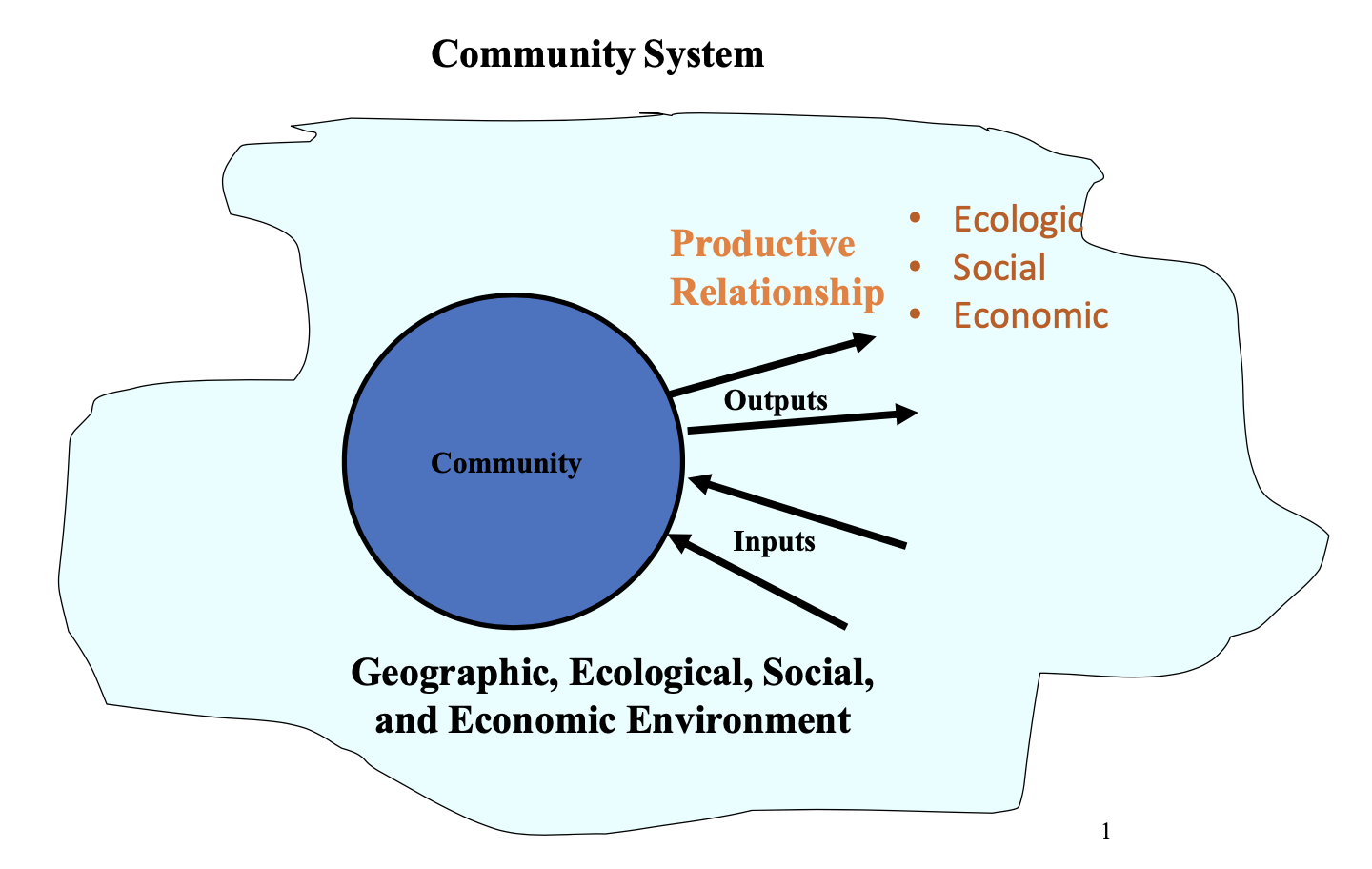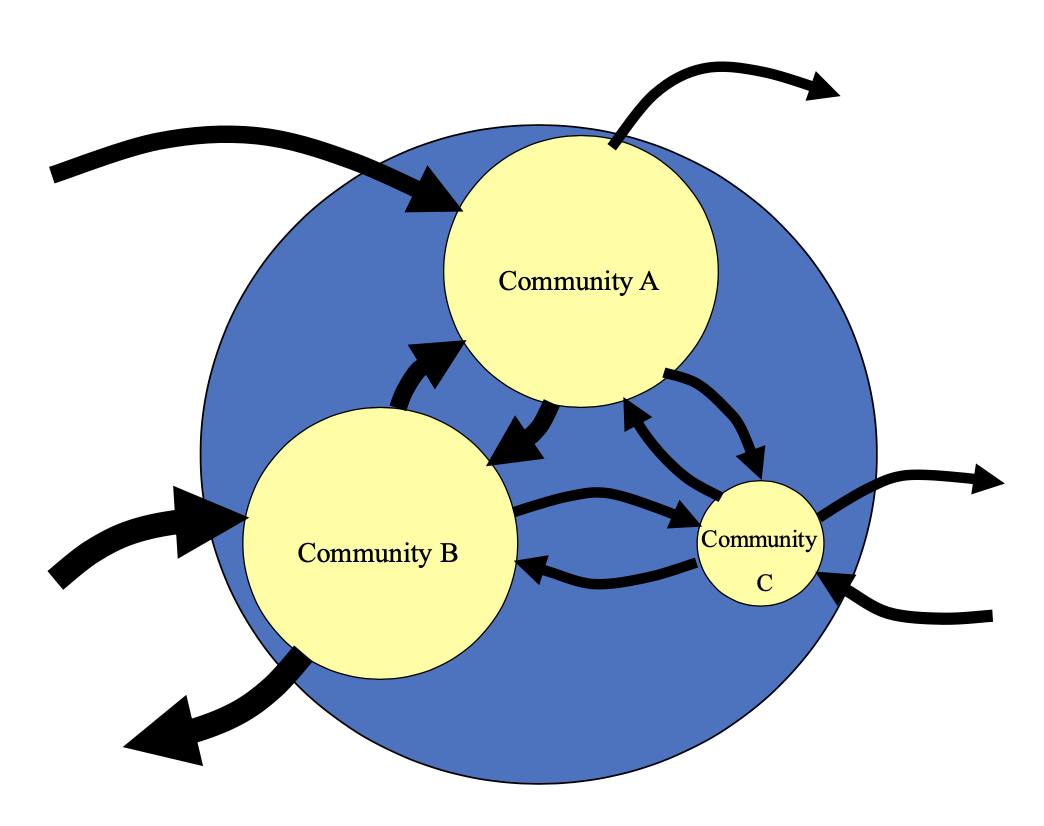# 8.3 Community and Purpose
For any animal the first priority is survival; survival for an animal means survival in its specific econiche. That econiche is contained in an ecosystem which in turn is shaped by the local geology, the shape of the land, the local weather, and the co-living species. The species homo sapiens evolved from its ancestors as a social animal. New members of ancient and modern hunter-gather groups are born into an ecosystem, and as children learn how to live by watching and listening to members of their group. At some point in the history of homo sapiens and its ancestors the skills in the manufacture and use of tools were discovered and developed. The development of these skills increased the variety of ways in which group members could relate, and therefore the increased the potential states of the group. The important point to note here is that in essence skill development and maintenance lies at the heart of trade and trading relations between communities. In the first instance the skills were those which exploit natural resources; the development of the ability to manufacture hunting tools, pottery, clothing, and cultivate crops. But of course today the variety of possible trading relationships is enormous. 5

Figure 8.2 Community System
Figure 8.2: A community in its environment
A community seeks to survive but in what way is the community going to relate to the environment in which it resides? I write these words sitting in a small apartment in a town which decided in the 1970’s to take advantage of its immediate coastal environment and determined that it would become a seaside holiday resort. It embarked on a massive building programme of constructing many small apartments, and also a marine lake for families and others not wishing to brave swimming in the Atlantic Ocean. In the winter it has a population of 1,700, in the summer 25,000. By doing this it became prosperous in the current world, but of course the question now is can it adapt to the changing world of increasing sea levels and fiercer storms. In this case both the individual community and the species of seaside holiday resorts is challenged.
My home town was a prosperous industrial town of the industrial revolution that has been long in decline. In 2017 two community enterprises came together to attempt to rescue the town’s semi-derelict community college to teach the theory and practice that will be necessary to counter climate change. It is an ambitious project to start to build a new green economy, and an attempt to answer the question of how my home community is to relate to the outside world in a new positive way. The question of how a community should relate to its outside world is a question that should be asked and answered for all communities of every type and size. What is this country, region, city, district, town, etc for? Or what does it wish to be? – these are not questions that I have heard often posed, but they are fundamental to sustainability. In most cases the restrictions imposed by ownership of community assets residing in the outside environment and not inside the community in question will prevent the community answering the question to its own satisfaction at all. History teaches us that without the ability and control to answer the question for itself, then a community will be overwhelmed by forces beyond its control at some time. Think about the closing down of the UK coal industry in the 1980s for example, when some communities lost their reason for being. Communities at all levels in large part lack the mechanisms for governing in order to be able to come together to consider the ways in which they 6 would seek to fit into a trading network of communities, and relate in a positive way to the earths ecological systems.

Figure 8.4: Trading communities
Figure 8.4: Trading communities
In practice what does this mean? How far could a community actually be self-sufficient? In our modern world most communities are not self-sufficient but need to contribute to the outside world in order to take in goods and services which it is unable to supply for itself. How will each community relate to other communities in the outside world – what trading relationships should it establish and what should it do for itself? Many communities struggle unsuccessfully against the almost completely unregulated feedback loop of capital creating more capital which has led to over-centralisation and exploitation Piketty 2020). We have much to learn from those peoples of the world who live sustainable relatively self-contained lives in harmony with their environment.
A community government will need to track the outside world, to watch trends and suggest changes and ensure that the outside world knows about the goods and services it can supply. It needs to ensure that the organisations that are needed to sustain its population and its relationship with the outside world are present and thrive. Therefore surely the first necessity of sustainability is to ensure that control is not passed to the outside by allowing outside ownership of community assets? This seems to be the opposite strategy to that which government agencies that I have interacted with have pursued for the whole of my lifetime. The mantra has always been that “we must attract outside investment”, that is give away our control. No wonder ‘take back control’ proved to be such an attractive slogan in the UK. A community must achieve a balance to allow in new ideas and learning, but not allow a critical loss of control. The second necessity of sustainability is to have the institutional ability to understand the relationships which the community has with its environment, both social and ecological, and the ways in which it must maintain the knowledge and skills by which the communities trading relationships are maintained. 7
I would propose that we need to be clear that in considering government for sustainability there are dimensions to government that is now substantially missing from our democratic institutional structures. At present these institutions are organized to cover social aspects of governing, but not the skill aspects of governing, nor really the ecological aspects of governing, that are required to develop and maintain inter- community trading relationships, and right relationship to the ecosystems of the earth.